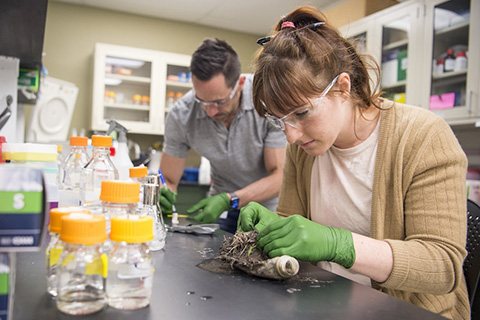News Release: NREL, UK University Partner To Dive Deeper Into How Enzymes Digest Plastic

The research determined two synergistic enzymes—PETase and MHETase—work effectively in tandem to break down polyethylene terephthalate (PET), which is a type of plastic used to make single-use beverage bottles, clothing, and carpeting. The research follows an earlier collaboration between these partners focused on PETase.
A bacterium, Ideonella sakaiensis 201-F6, was discovered in the soil outside of a Japanese PET bottle recycling plant in 2016 and was shown to secrete both PETase and MHETase. Researchers at NREL and Portsmouth were able to engineer PETase to increase its ability to digest PET, although still not fast enough to make the process commercially viable to handle the tons of discarded bottles littering the planet.
Gregg Beckham, a senior research fellow at NREL and co-lead of a new paper outlining the latest findings, said MHETase and PETase degrade PET faster than PETase alone. “They are better together than they are separate. PETase conducts the initial breakdown of the PET polymer, and MHETase further deconstructs the soluble products of PETase to produce the building blocks of PET,” he said. Genetically linking the separate enzymes makes them function even better. By itself, MHETase does not act upon PET.
The paper, “Characterization and engineering of a two-enzyme system for plastics depolymerization,” appears in the journal Proceedings of the National Academy of Sciences of the United States of America. The University of Portsmouth’s John McGeehan co-led the study.
Additional authors from NREL are Brandon Knott, Erika Erickson, Japheth Gado, Isabel Pardo, Ece Topuzlu, Jared Anderson, Graham Dominick, Christopher Johnson, Nicholas Rorrer, Caralyn Szostkiewicz, and Bryon Donohoe.
“The team assembled here is incredibly diverse and multidisciplinary,” said Knott, a chemical engineer. That enables hypotheses generated in one area to be immediately followed up on via computational or laboratory experiments.
MHETase has not been studied to date to the same extent as PETase. The new research combined structural, computational, biochemical, and bioinformatics approaches to reveal molecular insights into its structure and how it functions.
“Now we know in molecular-level detail how the enzyme actually works on MHET,” Beckham said.
Additional research discovered two other bacteria that contain enzymes like MHETase, bringing the total known enzymes that act on this synthetic substrate to three.
Research funds came from the U.S. Department of Energy’s Advanced Manufacturing Office and its Bioenergy Technologies Office. The work was performed as part of the Bio-Optimized Technologies to keep Thermoplastics out of Landfills and the Environment (BOTTLE) Consortium.
NREL is the U.S. Department of Energy's primary national laboratory for renewable energy and energy efficiency research and development. NREL is operated for the Energy Department by the Alliance for Sustainable Energy LLC.
Last Updated May 28, 2025
